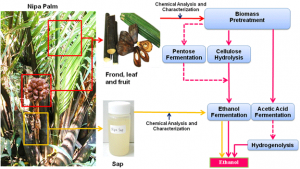Fermentation of Nypa Palm to Form Ethanol
Nypa fruticans - known as the Attap Palm (Singapore), Nipa Palm (Philippines), and Mangrove Palm or Nipah palm (Malaysia) - grows in brackish water, and is the only palm considered to be a mangrove. Nypa palms produce large quantities of a sugar-rich sap that can be used for ethanol production. Nypa palm has been reported to have ethanol yields ranging from 6480 to 20,000 liters/ha, which makes it several times more productive then the sugarcane. Nypa palms can be tapped after they are 5 years old and continue to produce until they are about 50. Nypa palms have several qualities that make them potentially sustainable. They are perennials that can be tapped year round. Tapping potentially produces less waste than fruit production, such as with oil palms. Large stands appear in the wild, meaning that it is possible to utilize wild growth rather than develop commercial plantations. However, the impact of large-scale tapping on ecosystems has not been determined. Nypa palms are an invasive species in Nigeria and elsewhere, that are threatening native mangrove populations.
Flow Diagram

(Source: http://www.ecs.energy.kyoto-u.ac.jp/english/kenkyu/image/kenkyu-2-zu2.gif)
Equipment
Video Links
References
- http://www.bioenergywiki.net/Nypa_palm
- http://www.ecs.energy.kyoto-u.ac.jp/english/kenkyu/image/kenkyu-2-zu2.gif
- http://en.wikipedia.org/wiki/Brackish_water